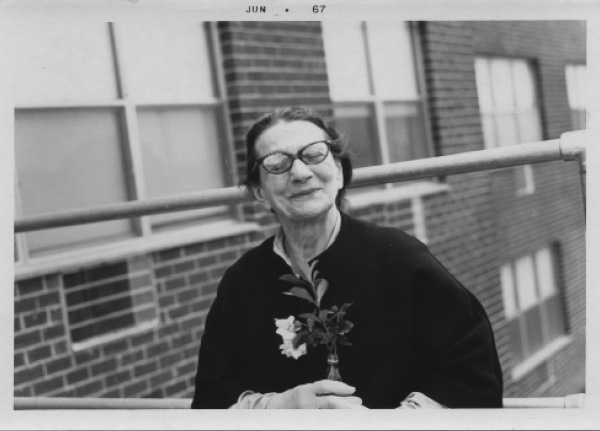
HERE I WAS BORN, AND HERE I DIED
first performed on April 29, 2017
Sullivan Galleries, Chicago, IL
performed sixteen times in 2017
ESTHER ROGATNICK / GEORGE OLKEN
Brooklyn, NY
georgeolken.com
HERE I WAS BORN, AND HERE I DIED
ESTHER ROGATNICK / GEORGE OLKEN
In Plan for a Photographic Project, Diane Arbus writes, “While we regret that the present is not like the past and despair of its ever becoming the future, its innumerable inscrutable habits lie in wait for their meaning. I want to gather them, like somebody’s grandmother putting up preserves.” Taking these words to heart, I used one wall of the School of the Art Institute of Chicago’s MFA Show 2017 to put up four paintings by my great-grandmother Esther Rogatnick (1895–1983).
An amateur painter who never showed her work publicly before, Grandma Esther was included in the exhibition’s press materials alongside other 2017 graduates. A wall label indicated her name, titles, and materials: The four works were untitled and undated. They may have had titles, I don’t know, and they were each made at a specific time. Next to them in the gallery was a separately labeled video monitor, upon which played images of the sequoia cut in Muir Woods in Vertigo (1958), La Jetée (1962), Sans Soleil (1983), 12 Monkeys (1995), and new images recorded by filmmaker Sam Ellison in 2017. (For an audio version, call 857-576-0001.) The only visible connection between these works was a note at the bottom of both labels: Tours daily at 3:00 pm.
The art gallery has become a theater for performative objects and performing bodies. The passive artwork—e.g. the painting or video—makes for (un)easy viewing: asking so much by conceding so little to its audience. We demand disruption in all things while ignoring domains rich with explorative possibilities because they remain static and silent. What does this do to history, to archives, and to art?
I performed throughout the exhibition in the guise of a gallery tour, responding obliquely to questions from the audience and adding new material each day. I began by introducing the artist and proceeded to narrate twentieth-century Jewish, personal, and film lineages. Through the activation of my presence, my great-grandmother’s traces become confused in multiple, parallel histories.
The price to escape the anti-Semitism my great-grandparents faced in Europe and then in New York, the success that bore its fruit in the middle-class lifestyle I inherited, was assimilation into whiteness. An unearned position of power so tenuous that the question “Are you Jewish?” still makes me uncomfortable over one hundred years later.
Am I an artist because of my great-grandmother? What else am I?